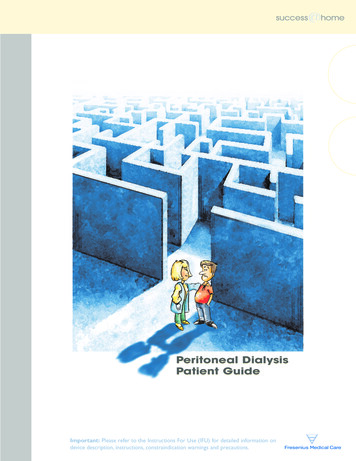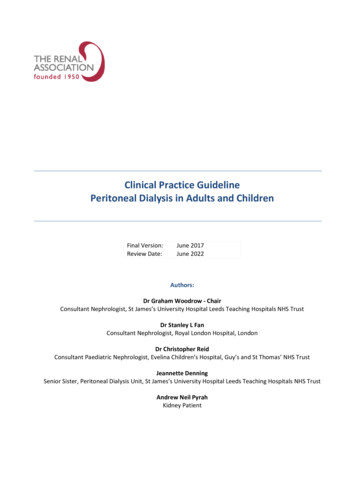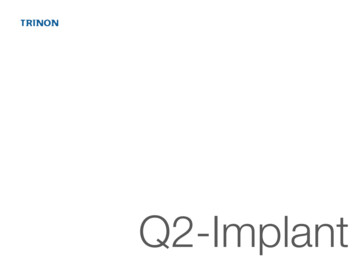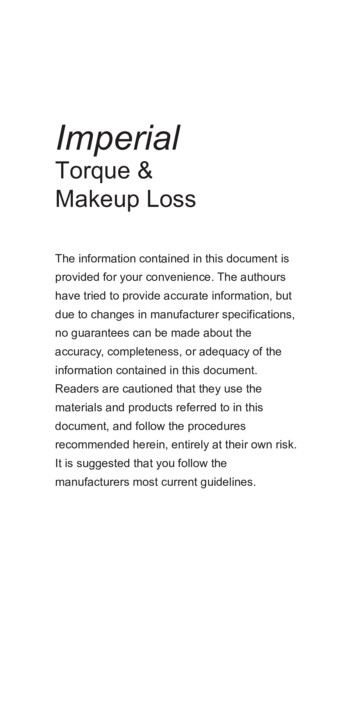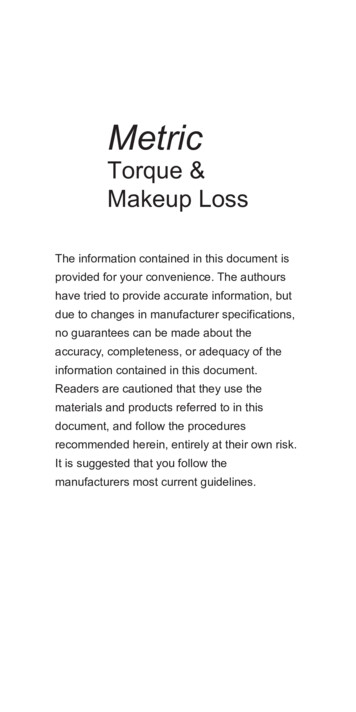
Transcription
Peritoneal Dialysis International, Vol. 37, pp. 362–374www.PDIConnect.com0896-8608/17 3.00 .00Copyright 2017 International Society for Peritoneal DialysisISPD GUIDELINES/RECOMMENDATIONSLENGTH OF TIME ON PERITONEAL DIALYSIS AND ENCAPSULATING PERITONEAL SCLEROSIS —POSITION PAPER FOR ISPD: 2017 UPDATEEdwina A. Brown,1 Joanne Bargman,2 Wim van Biesen,3 Ming-Yang Chang,4 Frederic O. Finkelstein,5 Helen Hurst,6David W. Johnson,7 Hideki Kawanishi,8 Mark Lambie,9 Thyago Proença de Moraes,10Johann Morelle,11 and Graham Woodrow12KEY WORDS: Peritoneal dialysis; encapsulating peritonealsclerosis; shared decision-making; ultrafiltration; membranetransport.Peritoneal dialysis (PD) is a successful dialysis modality thatenables patients with end-stage kidney disease to have ahome-based treatment with many advantages for their quality of life. In general, survival outcomes of PD are equal tothose of hemodialysis (HD). The reported technique successof PD is, however, shorter than that of HD. Whereas there are“positive” reasons for stopping PD, such as transplantationor recovery of renal function, some patients transfer to HDbecause of peritonitis, inadequate small solute clearance and/or ultrafiltration (UF), and social factors (1). “Adequacy” and“problems with maintaining euvolemia” as reasons for dropout increase over time, especially as residual renal functiondeclines. Nevertheless, even anuric patients can be maintainedsuccessfully on PD (2). Many patients are reluctant to transferto HD, even when clinically indicated, because they perceivethat such a transfer would adversely affect their quality ofCorrespondence to: Edwina A. Brown, Imperial College Renal andTransplant Centre, Hammersmith Hospital, London W12 0HS, UK.e.a.brown@imperial.ac.ukReceived 26 January 2017; accepted 4 April 2017.362life. A proper presentation of, and possible use of decisionaids about different renal replacement therapies, includinghome HD and the option of conservative care, from the startof treatment onward (integrated care) could potentially reducedisappointment when a transfer is needed (3–5).One of the potential, although extremely rare, complications of long-term PD is encapsulating peritoneal sclerosis(EPS); it is associated with high morbidity related to bowelobstruction and malnutrition. The reported mortality of thiscondition is around 50%, usually within 12 months of the diagnosis (6,7). Mortality rates, however, depend upon severity ofthe disease, and not all deaths are due directly to EPS alone(7). It has been advocated by some that there should be a timelimit for PD to prevent patients from developing this potentiallydevastating complication.The principal aims of this paper are:1. To review existing information about the epidemiology ofEPS and its risk factors;2. To determine whether there are any predictors for thedevelopment of EPS that would guide the decision to stopPD and transfer to HD; andPerit Dial Int 2017; 018Downloaded from http://www.pdiconnect.com/ by guest on August 21, 2017Imperial College Renal and Transplant Centre,1 Hammersmith Hospital, London, UK; University Health Network andthe University of Toronto,2 Toronto, ON, Canada; Renal Division,3 Ghent University Hospital, Ghent, Belgium;Kidney Research Center,4 Department of Nephrology, Chang Gung Memorial Hospital, Taoyuan, Taiwan; YaleSchool of Medicine,5 New Haven, CT, USA; Central Manchester and Manchester Children’s NHS FoundationTrust,6 Manchester, UK; Department of Nephrology,7 University of Queensland at Princess AlexandraHospital, Brisbane, Australia; Tsuchiya General Hospital,8 Faculty of Medicine, HiroshimaUniversity, Japan; Institute for Applied Clinical Sciences,9 Keele University, Stoke-on-Trent,UK; Pontificia Universidade Catolica do Parana,10 Curitiba, Parana, Brazil; Divisionof Nephrology,11 Cliniques universitaires Saint-Luc, Brussels, Belgium, et Institutde Recherche Expérimentale et Clinique, Université catholique de Louvain,Brussels, Belgium; and St James’s University Hospital,12 Leeds, UK
PDIJULY 2017 – VOL. 37, NO. 43. To reach a consensus that should be given to nephrologistsand their patients about the length of time that is advisableto remain on PD.GUIDELINES FOR EPSGuidelines on the topic of EPS have been issued by theJapanese Society for Peritoneal Dialysis (8), the UK RenalAssociation (9), and the Dutch EPS Registry (10). When reading the guidelines, it is clear that issuing evidence-basedguidelines on EPS is being hampered by:EPIDEMIOLOGY OF EPSEncapsulating peritoneal sclerosis is a very uncommon complication of PD. Its risk of occurrence has been demonstratedto vary markedly among centers, among countries, and overtime (Table 1). Based on the reports of various single-center,multi-center, and national registry observational cohort studies, the prevalence of EPS has been observed to vary between0.4% and 8.9%, its incidence rate between 0.7 and 13.6 per1,000 patient-years, and its risk of occurrence after 5 yearson PD between 0.6% and 6.6% (Table 1). A variable (0 – 71%)proportion of EPS cases are not diagnosed until after completion of PD (12,13), including following kidney transplantation(14). The appreciable variability in observed EPS incidence,prevalence, and timing of occurrence may be related togenetic factors, differences in PD care (e.g. daily prescribedPD volumes, dialysate glucose exposure, use of biocompatiblefluids, peritonitis prevention strategies, time spent on PD,etc.), or limitations of the studies published to date, including ascertainment bias, detection bias (e.g. under-diagnosingmild cases, over-diagnosing simple peritoneal fibrosis, lackof a reliable screening test, and failure to monitor patientsfollowing PD completion), inadequate length of follow-up(considering the usually long lag time to development of EPSfollowing PD commencement), and inadequate sample size(thousands of patients need to be followed for many yearsto provide sufficiently precise statistical estimates of risk forinforming clinical decision-making) (15). Most studies to datehave also failed to consider the competing risks of death andkidney transplantation (15).Some studies from Germany (16), Spain (17), Japan (18),Australia (13,19), and the Netherlands (20) have furthersuggested that the incidence of EPS may be decreasing overtime, although the reported incidence/prevalence estimateshave been too imprecise to be certain of this. If EPS is indeedbecoming less common, the reasons remain uncertain.Most studies have consistently identified increasing PDduration as a key risk factor for development of EPS (Table 1)(11,12,18,21–27). Other parameters that have been identifiedin at least 1 study to be possible risk factors for EPS includehigher dialysate glucose exposure, use of conventional PD solutions (as opposed to biocompatible PD solutions), peritonitis(frequent, severe, or prolonged), younger age (presumablybecause of lower competing risk of death), abdominal surgery, β-blocker use, icodextrin use, kidney transplantation,UF failure, and higher peritoneal solute transport rate (PSTR)(13,20–22,25,28–32). However, these data have been tooimprecise and/or inconsistent to be considered reliable atthis time.It should be stressed that all current data indicate thatthe majority of patients receiving PD for a long duration donot develop EPS. Clinicians switching patients who have beenon PD for several years to HD in an attempt to pre-emptivelycircumvent the risk of EPS (0.7 – 9.5 episodes per 1,000patient-years) should consider the alternative risks of HDcomplications, including arteriovenous fistula failure (47%at 1 year) (42), bacteremia (137 episodes per 1,000 patientyears) (43), and endocarditis (1.7 – 4.8 episodes per 1,000patient-years) (45,46). Other devastating complications of HDwith consequences as potentially dire as EPS include embolicstroke from vegetations caused by endocarditis (47), othermetastatic complications of bloodstream infections includingosteomyelitis and spinal epidural abscess (48), and centralvenous stenosis (49). Although these conditions appear to beat least as prevalent as EPS in PD patients, the literature onthese complications is scant.DIAGNOSIS OF EPSThe diagnosis of EPS is based on a combination of structural(e.g. computed tomography [CT] scan appearance) and functional features (intermittent subacute bowel obstruction). Itis important to be clinically aware of the possibility of EPS formany years after stopping PD; failure to listen to the patientand his/her symptoms may lead to a delay in diagnosis (50).Encapsulating peritoneal sclerosis presents after withdrawalfrom PD in the majority (70 – 90% in some series) of patients(11,51) and the time from cessation of PD until the development of EPS has been reported as up to 5 years (52). Thediagnosis is clinical, relies on a constellation of symptoms,and can be confirmed radiologically. Changes in the peritoneum need to be differentiated from those of long-term PD.Only a fibrous cocoon wrapped around the bowel is diagnostic; a thickened peritoneal membrane and intra-abdominal363Downloaded from http://www.pdiconnect.com/ by guest on August 21, 2017 A lack of well-defined diagnostic criteria, especially todetermine early stages of EPS; A lack of interventions that consistently improve outcomeof EPS, even after PD has been stopped; The fact that EPS may develop or symptomatically progressafter discontinuation of PD (11) and transfer to HD ortransplantation, making guidance about when to transferpatients electively from PD to HD particularly difficult; A lack of epidemiological data in different dialysis populations relating length of time on PD to odds of developingEPS (EPS has, however, rarely been reported to occur before3 years on PD); and Difficulties determining individual risk and impact fortransfer to HD given their comorbidities, personal situation,tolerance of HD, and need for vascular access.ISPD POSITION PAPER ON LENGTH OF TIME ON PD AND EPS: 2017 UPDATE
BROWN et al.JULY 2017 – VOL. 37, NO. 4PDITABLE 1Studies Examining the Epidemiology of EPS*CountryTimeperiodStudy designNPrevalence4648.9%EPS epidemiologyIncidence rate(/1,000patient-yrs)Risk with timeReference7 4 yrs: 8.6% 5 yrs: 10.8% 6 yrs: 23.3% 7 yrs: 25%Alatab et al.2017 (21)NANAKitterer et al.2016 l cohortGermany1997–2015Single-center,7454% (1995–2000)retrospective,(catheters) 0% (2001–2003)observational cohort5% (2004–2006)11% (2007–2009)15% (2010–2012)5% (2013–2015)15% (2010–2012)Scotland2000–2007ScottishRenal Registry1,2382.8%8.7 (by 2007)13.6 (by 2014)1 yr: 1.1%3 yrs: 3.4%4 yrs: 8.8%5 yrs: 9.4%7 yrs: 22.2%Petrie et al.2016 servational cohort9202.8%9.5 2 yrs: 3%2–4 yrs: 3%4–6 yrs: 4%6–8 yrs: 6%8–10 yrs: 8%10–12 yrs: 18%12–14 yrs: 75% 14 yrs: 67%Vizzardi et al.2016 servational cohort2704.8%NANAYamahatsuet al. e,observational cohort6792.9% (overall)5.6% (1980–1990)3.9% (1991–2000)0.3% (2000–2012)NANADe SousaAmorim et al.2014 tional cohort(55 centers)1,3381.0%2.3 3 yrs: 0.3%5 yrs: 0.6%8 yrs: 2.3% 8 yrs: 1.2%Nakayamaet al. e,observational cohort6061.3%1.4NAHong et al.2013 (34)Italy1986–2011Italian Registry ofPediatric ChronicDialysis712(children)1.9%NA 5 yrs: 0.45% 5 yrs: 21.1%Vidal et al.2013 rvational cohort(European PaediatricDialysis WorkingGroup, 14 centers)1,472(children)1.5%8.7NAShroff et al.2013 (35)364Downloaded from http://www.pdiconnect.com/ by guest on August 21, 2017Iran
PDIJULY 2017 – VOL. 37, NO. 4ISPD POSITION PAPER ON LENGTH OF TIME ON PD AND EPS: 2017 UPDATETABLE 1 (cont’d)CountryTimeperiodNPrevalenceRisk with e,observational cohort7618.4% ( 5 yrs)NANAGayomali et al.2011 (37)1 January1996 – 1 July2007Multicentercase-control study2,0222.7%NANAKorte et al.2011 rvational cohort6761.2%NA 6 yrs: 15% 9 yrs: 38%Bansal et al.2010 bservational cohort1,9661.1%NANATrigka et al.2011 observational cohort6151.98%3.2 6 yrs: 20% 8 yrs: 100%Phelan et al.2010 (25)Australia andNew Zealand1995–2007Binational Registry(ANZDATA)7,6180.4%1.83 yrs: 0.3%5 yrs: 0.8%8 yrs: 3.9%Johnson et al.2010 ,observational cohort4231.2%NANALindic et al.2009 (39)Scotland2000–2007ScottishRenal Registry1,2381.5%4.9 1 yr: 0%1–2 yrs: 0.6% 2–3 yrs: 2.0% 3–4 yrs: 3.5% 4–5 yrs: 8.1% 5–6 yrs: 8.8% 6 yrs: 5%Brown et al.2009 servational cohort104(children)1.9%NANAEkim et al.2005 vational cohort(7 centers)4,2900.79%(center variation0.28–2.86%)NANAKim et al.2005 (28)JapanApril 1999–March 2003Multicenter,prospectiveobservational cohort(57 centers)1,9582.5%NA3 yrs: 0%5 yrs: 0.7%8 yrs: 2.1%10 yrs: 5.9%15 yrs: 5.8% 15 yrs: 17.2%Kawanishiet al.2004 vational cohort(5 centers)3,8880.8%NANALee et al.2003 (30)USANetherlands365Downloaded from http://www.pdiconnect.com/ by guest on August 21, 2017Study designEPS epidemiologyIncidence rate(/1,000patient-yrs)
BROWN et al.JULY 2017 – VOL. 37, NO. 4PDITABLE 1 (cont’d)CountryTimeperiodStudy designNPrevalenceEPS epidemiologyIncidence rate(/1,000patient-yrs)Risk with timeReferenceApril 1999–March 2001Multicenter,retrospectiveobservational cohort(64 centers)2,2160.77%NA 5 yrs: 0.3% 5 to 10 yrs: 0.5% 10 yrs: 3.3%Kawanishiet al.2001 vational cohort(60 centers)687(children)1.6%NA 5 yrs: 6.6% 8 yrs: 12%Hoshii et al.2000 bservational cohort7,3740.7%1.9 (1980–1989)4.2 (1990–1994) 2 yrs: 1.9% 5 yrs: 5% 6 yrs: 10.8% 8 yrs: 19.4%Rigby andHawley1998 servational cohort1973.7%2.6NAYokota et al.1997 ol4073.9%3.5NAHendriks et al.1997 (32)EPS encapsulating peritoneal sclerosis; NA not applicable.*Presented in order of publication from most recent to oldest.adhesions are common in long-term PD and after peritonitis,particularly tuberculous peritonitis, and are therefore notdiagnostic (52).Clinical Features of EPS: The diagnosis of EPS is based on acombination of bowel obstruction and features of encapsulation due to peritoneal fibrosis. Symptoms such as anorexia,nausea, vomiting, and weight loss are common. In addition, thestep-wise process of symptom progression is important. If thecapsule formed is too thin to impair intestinal peristalsis, EPSdoes not develop (encapsulating stage). However, if the capsule thickens with time, bowel obstruction symptoms appear(ileus stage). These symptoms improve by temporary fasting,but recur several months later. If the time to recurrence gradually shortens, EPS is diagnosed. Clinically, this progressionmanifests itself with early symptoms (bloody ascites, appetiteloss, nausea, diarrhea, and abdominal pain), progressing tomore severe symptoms, including constipation and abdominalmass accompanied by severe malnutrition and weight loss.Sometimes, early EPS presents with an inflammatory stateincluding fever, general fatigue, and slight weight loss, withan elevated C-reactive protein, anemia, and hypoalbuminemia.The intermittent progression, and therefore symptoms, of EPSis a useful distinguishing feature from other gastrointestinaldisorders (53).Radiological Diagnosis of EPS: Of the techniques available,computed tomographic (CT) scanning has been reported as366having the most discriminant value (52). It is also widelyavailable and has the greatest reproducibility. Computedtomographic scanning is therefore recommended as thefirst investigation. The features that have been shown tohave a high degree of agreement among radiologists areperitoneal calcification, bowel thickening, bowel tethering, and bowel dilatation (54,55). It should be stressed thatfinding these changes on CT scan does not suffice to makethe diagnosis of EPS, especially not in the absence of thesymptoms described above. Many long-term PD patients willhave thickening of the peritoneal membrane without anyfeatures of EPS.Pathological Features of EPS: A characteristic macroscopic appearance is observed at laparotomy or laparoscopy.Histological changes that are characteristic of EPS have beendescribed but are not specific and overlap with membranechanges that occur with UF failure and infectious peritonitis inlong-term PD (56). Thus, an “opportunistic” peritoneal biopsyat the time of incidental abdominal surgery in the absence ofother features of EPS may be misleading and should not beused to make a diagnosis of EPS.Membrane Transport Characteristics: Changes in PSTR arefrequent in PD. It has been recognized for many years that UFcapacity falls and there is an increase in PSTR prior to development of EPS (57). These membrane changes are, however, alsocommonly observed in patients on long-term PD who do notDownloaded from http://www.pdiconnect.com/ by guest on August 21, 2017Japan
PDIJULY 2017 – VOL. 37, NO. 4develop EPS. The Pan-Thames EPS study showed that, whilethe majority of patients had high PSTR, some developed EPSin the absence of these membrane changes and had good UF(6). These changes are discussed in more detail in the sectionon predicting EPS.MANAGEMENT OF EPSRENAL TRANSPLANTATION AND EPSAlthough there were repor ts from the UK and theNetherlands (73–75), the numbers from these reports aresmall and there is still no evidence of a genuine sustainedincrease in the occurrence of post-transplant EPS. Balancedagainst this, there have been isolated reports of dramaticresolution of established EPS following renal transplantation,possibly as a result of immunosuppression (76). Indeed, aprior diagnosis and treatment of EPS is not a contraindication to transplantation. Encapsulating peritoneal sclerosisoccurs after transplantation only in patients who have beenexposed to PD for several years; there appears to be no riskif patients have been on PD for a short time. Ideally, therefore, patients should be transplanted within 3 – 4 years ofstarting PD. This requires appropriate patient education,efficient workup, access to the national deceased organwaiting list, and encouragement of living donation. Thesame is true for patients on HD so that patients can benefitfrom the improved survival and quality of life associated withsuccessful transplantation.SCREENING FOR EPSThere is no reliable screening tool established for EPS.Change in PSTR across the peritoneal membrane is not particularly helpful. A rise in PSTR is common in patients on long-termPD and therefore is commonly found in patients subsequentlydeveloping EPS. As discussed, though, EPS can also occur inpatients with slow PSTR. Similar observations and conclusionsapply to loss of UF.Computed tomographic scanning has been proposed asa screening tool, but EPS can occur within a year or less of anormal CT scan in asymptomatic patients (77). In contrast,long-term patients on PD with minor abdominal symptomsin this study were sometimes found to have minor CT scanabnormalities; all such patients then progressed to the fullEPS clinical syndrome on stopping PD.PREDICTING EPSEpidemiology: When predicting the absolute risk of EPS, forboth clinical and statistical reasons, it is not possible to ignorethe competing risk of death. Methods such as the Kaplan-Meierestimator will not account for competing risks and thereforewill overestimate the level of risk (78). Work for the PeritonealDialysis Competitive Risk Analysis for Long-Term Outcomes(PD-CRAFT) study using data from the ANZDATA registry and theScottish Renal Registry has verified this phenomenon, showingincreasing disparity with longer follow-up. As is clearly shownin the studies of the epidemiology of EPS, duration of PD isstrongly associated with EPS risk. In competing risks prediction models for patients in ANZDATA 3 and 5 years after thestart of PD using age and primary renal disease as predictorsof mortality and duration of PD as a predictor of EPS, most ofthe variability in EPS incidence was explained (unpublished367Downloaded from http://www.pdiconnect.com/ by guest on August 21, 2017It is generally accepted that, after a diagnosis of EPS, PDshould be discontinued and the patient transferred to HD.However, it should be considered that some cases of EPSare clinically less severe and potentially could worsen uponstopping PD. The eventual risks of HD (access, access-relatedinfection, hemodynamic intolerance, lifestyle issues, andpatient preference) should also be considered carefully ina discussion with the patient about the best future renalreplacement therapy option. Generally, the PD catheteris removed on discontinuing PD. Some patients in Japanhave been managed by leaving the catheter in situ to applyregular peritoneal lavage (58,59). It is unclear whether thisprocess has any beneficial effects by removing mediatorsof the peritoneal fibrotic process, or whether the catheterand irrigation fluid could act as a further stimulus to theEPS process.Nutritional support (often by parenteral nutrition) iscrucial in patients with EPS, many of whom will recover withconservative treatment (60). In addition, drug therapies thathave been reported to have beneficial effects in EPS includecorticosteroids (11,61), tamoxifen (62–64), and immunosuppression (65–67). The fact that EPS can actually developfollowing renal transplantation in patients already receivingcorticosteroids and/or other immunosuppressive agents may,at least theoretically, argue against any therapeutic benefitof these drugs. Most of these reports are limited to isolatedcases or relatively small series, have not been uniformly successful, and are potentially limited by other interventions,selection, and positive publication biases. The 2 larger studiesgave conflicting results. The study from the Netherlands (63patients) found that the mortality of the tamoxifen groupwas lower than those not given the drug (64). In contrast,in a large UK series (111 patients), there was no differencein outcomes for patients treated with steroids, immunosuppression, tamoxifen, or combinations of these comparedwith patients that were not (6). No definitive conclusionscan therefore be drawn at this time about their value in themanagement of EPS.On the basis of successful surgical results from Japan(51,68,69), aggressive surgical treatment for when there wasno improvement of bowel obstruction was started in the UK(70) and Germany (71,72). From these reports, it appears thatwith surgery, EPS mortality rate declines to 32 – 35%. It mustbe stated, though, that for surgical results to be successful,the surgical team must have a thorough understanding of thepathology of EPS. Such surgery should therefore only be donein specialist regional centers that can provide appropriatesurgical training and patient support.ISPD POSITION PAPER ON LENGTH OF TIME ON PD AND EPS: 2017 UPDATE
BROWN et al.data from PD-CRAFT), i.e. the ‘real-world’ risk of EPS is almostentirely due to the risk of death and the duration of PD. Noprediction models are available for clinical usage currently asthe baseline risk is not yet clear due to the variability in EPSincidence described previously.Despite the very strong effect of the duration of PD and riskof mortality, clinicians may wish to further stratify patientsat risk of EPS. Data on this are not robust enough for strongguidance as there are no datasets with sufficiently detailedinformation on the very large populations required to studyEPS. There are several small, mostly single-center, studiesthat have examined membrane function testing and dialysatebiomarkers for this purpose, and they have all been predicatedon the same pathophysiological model for membrane damage.368PDIconductance and abolition of sodium sieving are not associated with any change in the expression of aquaporin-1 (AQP1)water channels in the peritoneal capillaries of patients withEPS (97,98).Biomarkers: As the current pathophysiological model forEPS risk is based on chronic inflammation and fibrosis withinthe peritoneum, the use of biomarkers from the peritonealeffluent has been suggested to improve the prediction ofEPS. They have therefore been tested to assess the risk ofEPS in 4 different case control studies either fully or partially matched for duration of PD using prospectively collecteddialysate samples (99–102). The consistent finding is thatseveral inflammatory cytokines (interleukin-6, tumor necrosisfactor-α, monocyte chemoattractant protein-1, chemokineligand 15, and plasminogen activator inhibitor-1) are slightlyelevated up to several years before EPS, supporting a rolefor chronic peritoneal inflammation in the physiopathology of EPS. However, the levels of biomarkers in the effluentshow significant variability (a lognormal distribution) andthe differences between cases and controls, whilst statistically significant, have been small and therefore of debatableclinical significance. Whether functional measurements orbiomarkers, when combined with PD duration and risk factors for mortality, improve the prediction of EPS has notbeen tested prospectively.PREVENTION OF EPSAs discussed, the incidence of EPS increases significantlywith time on PD, particularly after 5 or more years of treatment,but the majority of long-term PD patients will not develop EPS.Importantly, EPS may develop or worsen after stopping PD.There are no prospective data demonstrating any benefit ofpre-emptively switching long-term PD patients to HD. A modality switch could also have significant adverse psychosocial andmedical implications for patients, which need to be consideredon an individual basis. Long-term access for HD also needs tobe discussed and planned with the patient; the risk of infectionfrom temporary HD access is considerably higher than the lowrisk of EPS at some point in the future.If considering switching patients from long-term PD toHD pre-emptively because of concern about risk of EPS, itmay be appropriate to select those patients with potentiallyadverse features for a high risk of PD technique failure suchas high and rising peritoneal permeability, low UF capacity,difficulty in fluid balance control, and requirement for highglucose concentration dialysate, as well as those with frequentepisodes of peritonitis. These features would then possiblyselect those at greater risk of PD technique failure. The effectof this management on EPS risk is, however, unknown. It wouldbe important to ensure that these patients are monitoredspecifically for clinical features of EPS, which can developsome time after switching to HD. Informing patients of theearly signs of EPS was recommended in a study of patientexperiences in particular at the time of transition to HD asDownloaded from http://www.pdiconnect.com/ by guest on August 21, 2017Membrane Function: As already discussed, longitudinalfollow-up of peritoneal membrane function has shown thatEPS is associated with progressive transport defects, includingexcessive increase in PSTR and loss of UF capacity as comparedwith control long-term PD patients (6,29,32,79–88) (summarized in Table 2). As PSTR predominantly reflects peritonealinflammation (89,90) and EPS is an inflammatory condition,changes in PSTR appeared a promising risk marker for epidemiological and pathophysiological reasons. More recentlongitudinal studies carefully matched for duration of PD toaccount for the association between PSTR and duration of PD(91) suggest that differences in PSTR are apparent only in thelater stages prior to EPS, therefore limiting its application asa potential risk indicator (83,88).Progressive uncoupling between solute and water transportacross the EPS peritoneal membrane (a loss of UF capacitydisproportionate to the rise in PSTR) (92), thought to be dueto fibrosis, led to the hypothesis that functional measures ofthis fibrosis may be a more reliable and earlier indicator of therisk of EPS (83). This hypothesis was verified in case-controlseries demonstrating a reduction in osmotically-driven waterflow across the peritoneal membrane (estimated by eithersodium sieving, free-water transport, or direct assessment ofosmotic conductance) in EPS patients (89,90). In daily clinicalpractice, the modified 3.86% glucose-based peritoneal equilibration test (PET) accurately evaluates UF capacity, allows thediagnosis of UF failure (defined as a net UF 400 mL after 4 h),and provides the opportunity to determine sodium sieving,estimated either by the change in dialysate-over-plasma ratioof sodium or by the dip in dialysate sodium concentration during the first hour of the dwell (93). As a biochemical measure,it is theoretically more reliable than volumetric assessmentof UF, which may be highly variable and influenced by otherfactors such as catheter patency.The combination of functional and structural analysisof the membrane of patients with EPS demonstrated thatreduced osmotic water transport is directly related to thedegree of fibrosis and to changes in collagen density andstructure in the peritoneal interstitium (88), in line withpredictions based on the serial pore-membrane/fiber matrixand distributed models (94–96). Of note, the low osmoticJULY 2017 – VOL. 37, NO. 4
PDIJULY 2017 – VOL. 37, NO. 4ISPD POSITION PAPER ON LENGTH OF TIME ON PD AND EPS: 2017 UPDATETABLE 2Case Series and Registry Studies Reporting Data on Membrane Function in Patients with EPS*CountryTimeperiodStudy designNumberof EPSpatientsNumberof controlpatien
after discontinuation of PD (11) and transfer to HD or transplantation, making guidance about when to transfer patients electively from PD to HD particularly difficult; A lack of epidemiological data in different dialysis popula-tions relating length of time on PD to odds of developing EPS (EPS has, however, rarely been reported to occur before
